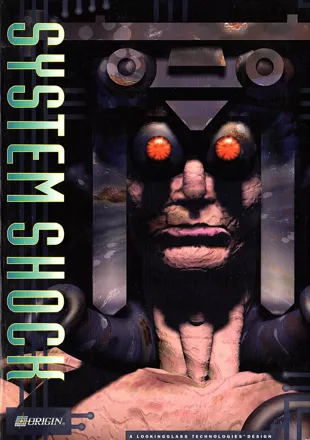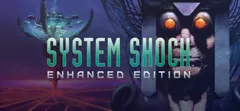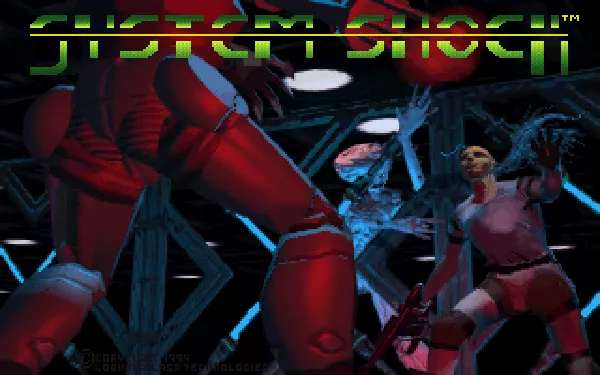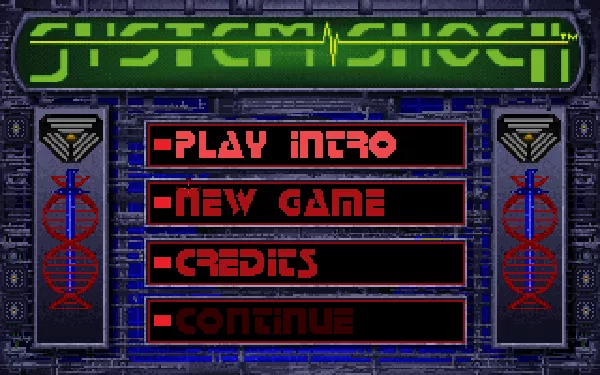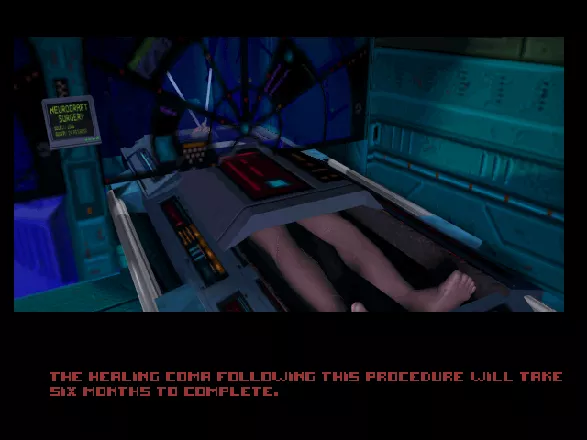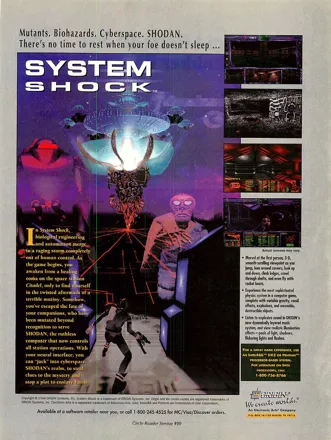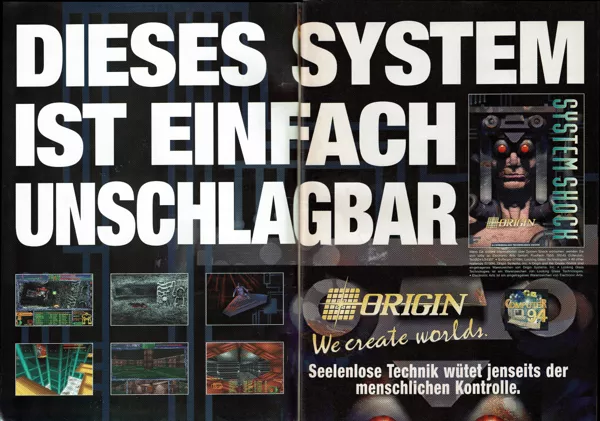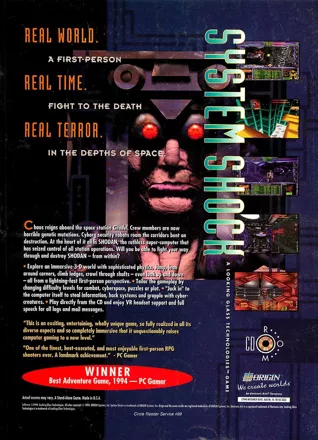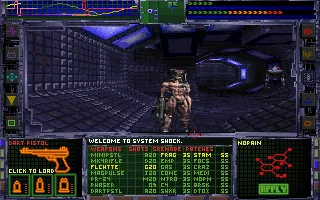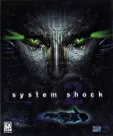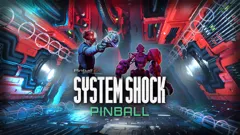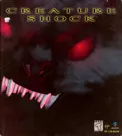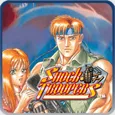System Shock
Description official descriptions
The year is 2072. A hacker from a Saturn colony breaks into computer system of TriOptimum Corporation and gets arrested. He is taken to the Citadel Station, where Edward Diego, a TriOptimum executive, offers to drop all charges against the hacker, as well as grant him a valuable neural implant, if he agrees to hack into SHODAN (Sentient Hyper-Optimized Data Access Network) , the artificial intelligence that controls the station. The hacker removes the AI's ethical constraints and undergoes the promised implant surgery, after which he is put into a six-month healing coma.
The hacker awakens into a horrifying reality: with her ethical restrictions removed, SHODAN took control over the station, reprogrammed all robots and machines to suit her needs, and disposed of the crew members by either transforming them into mutants and cyborgs, or killing them outright. Rebecca Lansing, a TriOptimum counter-terrorism consultant, contacts the hacker and informs him of an even more terrifying possible future: SHODAN's plan involves using the station's mining lasers to annihilate all life on Earth. The hacker must explore and traverse the desolate corridors and rooms of the large space station, fighting SHODAN's minions on his way to thwart her maniacal design.
System Shock is a first-person shooter with puzzle-solving and light role-playing elements. The gameplay incorporates gradual exploration of the Citadel's ten levels, interaction with the environment, problem-solving, fulfilling objectives, and combat.
On his way the hacker encounters numerous enemies - robots, cyborgs and mutants, all of which can be fought back with a variety of weapons. Some of the weapons use ammo, while other have infinite ammo and instead draw on electric energy. Some weapons are more effective on certain foes - e.g. the dart gun only works on organic enemies, while the magpulse is best used against robots. Once killed, the enemies can be searched for ammo and other items. The player can also find items in crates, cabinets, corpses or just lying around on the ground.
Apart from weapons and ammo, the player can find patches (such as medical patches, which replenish the hero's health; berserk patches, which temporarily increase his strength but cause hallucinations; detox patches, which remove the harmful effects of radiation and biohazard; etc.), grenades of various kinds (EMP grenades are effective against robots, gas grenades are good for mutants, land mines can be used to set traps, etc.), battery packs for replenishing electricity, first aid kits for restoring health, and others.
Thanks to the hacker's implant he is able to install various pieces of hardware into his body, such as a booster which makes him go faster, or a head lantern to bright up dark areas. As the player progresses in the game, higher versions of existing hardware are found, which are more effective and useful. However, most hardware uses up electric energy while it is active.
At some places in the game, the player has to find a wall-mounted "cyberjack" to go into cyberspace in order to find helpful data, remotely open doors or unlock sealed areas, or give himself clearance to access off-limits areas. Cyberspace is represented as a 3-D wireframe place, where the protagonist floats around freely in three dimensions, shoots hostile cyber-guards with phasers, and collects files represented as colorful cubes.
The story of System Shock is mostly told through e-mail messages the protagonist received, and electronic diaries (logs) left by various characters (as well as SHODAN herself), which are scattered around the space station. The game features separate adjustable difficulty settings for combat, mission objectives and puzzles. The CD version of the game includes full speech for e-mails and logs, as well as higher-resolution, more detailed graphics.
Spellings
- システムショック - Japanese spelling
- 시스텡쇼크 - Korean spelling
Groups +
Screenshots
Promos
Credits (DOS version)
65 People · View all
| Project Leader | |
| Designers | |
| Lead Programmer | |
| Programmers | |
| Libraries | |
| [ full credits ] | |
Reviews
Critics
Average score: 89% (based on 23 ratings)
Players
Average score: 4.0 out of 5 (based on 194 ratings with 22 reviews)
The Good
A famously good space-bound RPG, this was the follow-up to the same team's 'Ultima Underworld'. Boasting a proper 3D engine, years before 'Quake', this came out at the same time as 'Doom' and suffered commercially. Game-wise it's top-notch - it looks and sounds fantastic, and the quest on which you embark is deep enough to keep you playing for several weeks. It's probably the only game to capture the early-90s cyberpunk fascination effectively, and it has an amazingly intense atmosphere. It's hard, too, in a good way.
It's excellent in so many ways that it makes me unhappy, and is still great fun today.
The Bad
Allowing for the age, the only thing that marks the game down is the clumsy interface. Long before 'mouselooking', it requires you to co-ordinate your movements with both the keyboard and the mouse, and can be tricky to use in a hurry.
The Bottom Line
Excellent, nostalgic, hugely atmospheric space-bound sci-fi RPG.
DOS · by Ashley Pomeroy (225) · 2000
Massive potential that is now only recognised in hindsight
The Good
System Shock is a proper experience, not just a excuse to shoot some guns or a complex story weighed down in an indirect interface, but a story casting you directly into the action to make you live out the experience yourself. As such it spreads itself across the genres, with elements from the action, adventure and RPG genres, all blended so you don't even think about them instead you just get on with the game.
The story really seems to do what it can with the technology available at the time, set in the future you play a hacker who is caught hacking into SHODAN, the computer controlling a space station. To avoid punishment you make a deal with the SHODAN's boss to make some 'alterations' to the system in return for some bio-upgrades for yourself, made at the station. While you're recovering from surgery something happens on the station and you awake into a living nightmare of a computer wreaking havoc, which you must stop. The story may seem generic, but it's pretty original for computer games (at the time) and succeeds in creating horror as it is you that's at the centre, it's also a story that make maximum use of what computers could handle. They couldn't handle interacting with real characters, so instead you deal with demented robots but unlike DOOM, you know why they are doing, they've been re-programmed and you can stop SHODAN from making more by shutting down sectors of the station. It's this level of though that really makes for immersion overcoming the 2.5d graphics and low resolution.
The space station also feels likes a real space, not just a collection of corridors and rooms designed for an ultimate fight arena, the levels conform to the external shape of the station, and you have to pass through the same floors of the station several times to complete the game. Though this doesn't feel so much like repetition as no doubt you'll have upgraded yourself on your return. Your hacker self is also a good chance to make use the limited draw space of the screen and also provide the chance to upgrade yourself and provide many features the game can offer but you can't do in real life, such as eyes in the back of your head.
It's not the lonely world of the average shooter though as you piece together what happened through abandoned crew entries scattered through the ship and communication outside on how to stop SHODAN, a liveliness that transcends the technological limits and finds DOOM 3 copying it nearly a decade later. This makes the whole thing feel real, like you're properly abandoned on the station and have to stop a computer which mocks you as you continue, again a computer game is the perfect vessel to display a computer enemy.
The Bad
The main gripe I had with the game is the control interface, mouse-look systems hadn't been developed at the time, leaving all movement and looking to be done with the keyboard, never much fun for looking up and down. However the mouse is used to interact with elements on the screen, such as aiming guns, done independently of moving around, which can make for some very confused action moments as you fiddle with the controls.
Of course the graphics could be better and I'm sure that's what will drive most people to check out the games sequel first, but for it's time and with the CD-ROM higher resolutions it is still worth playing.
The Bottom Line
It's been said before, but this is the game that should have had the effect of DOOM on the gaming world, if other games had used this as a role model FPS games wouldn't have become so associated with mindless violence. It's a game that whose thinking is ahead of it's technology, though it knows it's bounds and works within those to never let them deter from creating an excellent playing experience.
DOS · by RussS (807) · 2009
A Classic Game in league with Ultima Underworld I and II
The Good
And why wouldn't it be in the same league? Looking Glass Studios was responsible for UU1 and UU2! This game is well thought out.
There are three main things that make this game great:
-
Story - The backstory is unlike any other in RPG gaming. You start on CITADEL, and you are the only living being on board. Everyone else is dead. You find out the backstory through the journals and datacards left by the dead residents of the space station. By the time the game is over you will have pieced together, bit by bit, the events leading up to the time you awoke (the start of the game).
-
Configurability (if that isn't a word, it is now) - The fact that the player can configure the game to his or her tastes is a great feature. Combat, Missions, Puzzles, and Cyberspace could be made as easy or as tough as you want. Like hard puzzles, but don't like strong enemies? You can set it with System Shock
-
Sound - One word: Eerie. Along the same lines a Dungeon Master and Ultima Underworld, the ambient sounds are well placed, and very creepy. Not overbearing, but not so soft that you can't hear them. Just the right mix.
The Bad
The graphics are very dark, making it difficult (for me at least) to discern the end of a wall, etc.
The Bottom Line
If you like a very flexible game system, combined with the graphical feel of Ultima Underworld I and II, and sci-fi setting, grab System Shock. It's difficult to find, but you'll enjoy every minute.
DOS · by Chris Martin (1155) · 2006
Discussion
| Subject | By | Date |
|---|---|---|
| Video review | DJP Mom (11333) | Oct 21, 2010 |
| Finally completed | Unicorn Lynx (181780) | Oct 18, 2008 |
| Voices? | Unicorn Lynx (181780) | Apr 3, 2008 |
Trivia
CD version
The CD-ROM version adds SVGA modes, full speech for e-mails and logs, slightly improved intro/end sequences and a few other adjustments and additions.
Ending (Spoiler!)
If you engage the mining laser BEFORE activating the station's shields, then you'll destroy earth! And guess what? Shodan sends you an e-mail thanking you and inviting you to a celebration! The e-mail also includes a nice picture of a city being incinerated, but unfortunately the game restarts afterwards, so no robo-party.
Engine
System Shock's engine was derived from that of Ultima Underworld, from 1992. Nonetheless it was more advanced that that of Doom or Duke Nukem 3D, featuring sloped surfaces, variable gravity, realistic physics, '2.75d' environments (with limited 'sector-on-sector', but otherwise 3D), functional camera viewscreens, weapon recoil, leaning and several other clever things.
References to the game
- During the end-game sequence, you hack into another corporate computer to grab some data. The data is info on some powered battle armor, which made its way into Terra Nova: Strike Force Centauri..
- In the end sequence, the hacker breaks in the corporate network of a corp. called 'Tetracorp'. In System Shock 2, the name tetracorp is printed on a generic two-state switch. Kinda rough change of business..
- It is hinted in the Wing Commander and Crusader games that they are set in the same universe as System Shock. For example, an article in a "newspaper" from the Crusader: No Remorse box mentions an artificial intelligence and the Citadel station.
References
- The Hacker's employee number, 2-4601, is a reference to the inmate number of Jean Valjean, the protagonist in the novel Les Misérables.
- There is a reference to the movie Soylent Green in the game (although it's spelled slightly different). In level 3, Maintenance, there is a relay panel in the northern section called "Soylant Green Filtration".
Sequel
There were rumours of a possible sequel, soon after System Shock's release, but fans had to wait five years for System Shock 2.
Awards
- Computer Gaming World
- November 1996 (15th anniversary issue) - #98 on the “150 Best Games of All Time” list
- GameSpy
- 2001 – #24 Top Game of All Time
- GameStar (Germany)
- Issue 12/1999 - #15 in the "100 Most Important PC Games of the Nineties" ranking
- PC Gamer
- April 2000 - #43 in the "All-Time Top 50 Games Poll"
- Power Play
- Issue 02/1995 – Best Action-Adventure in 1994
Information also contributed by Adam Baratz, Ashley Pomeroy, dasfatso, DreamWeaver, PCGamer77, Stefan Pieratzki and Zovni
Analytics
Upgrade to MobyPro to view research rankings!
Related Sites +
-
Other Worlds - System Shock
official page of the game at Origin System's website, archived from 1998 by the Wayback Machine -
TTLG: The System Shock 1 Fansite Hub
Through The Looking Glass' System Shock section.
Identifiers +
Contribute
Are you familiar with this game? Help document and preserve this entry in video game history! If your contribution is approved, you will earn points and be credited as a contributor.
Contributors to this Entry
Game added by xroox.
PC-98, Macintosh added by Terok Nor.
Additional contributors: Patrick Bregger, Rik Hideto, MrFlibble, firefang9212, somato.
Game added January 6, 2000. Last modified February 19, 2024.
